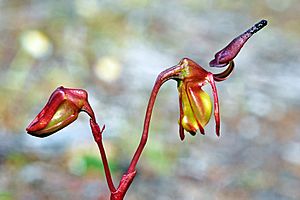Hort's duck orchid facts for kids
Quick facts for kids Hort's duck orchid |
|
|---|---|
 |
|
| Scientific classification | |
| Synonyms | |
|
The Caleana hortiorum, also known as Hort's duck orchid, is a special type of orchid. It is found only in the south-west part of Western Australia. This unique plant gets its name because its flower looks a bit like a duck in flight!
It has one smooth leaf and usually a single flower. The flower is greenish-yellow and red. A key feature is its long, narrow, slightly humped part called the labellum. This part has small bumps, called calli, on its outer half. You can find this orchid growing between the cities of Perth and Albany.
Contents
What Hort's Duck Orchid Looks Like
Hort's duck orchid has a single, smooth leaf. The leaf is usually dull green or dull red. It is about 10 to 20 millimeters (0.4 to 0.8 inches) long. The leaf is also about 4 to 8 millimeters (0.16 to 0.31 inches) wide. Unlike many other duck orchids, its leaf does not dry up when the flower blooms.
Usually, only one flower grows on each plant. This flower is greenish-yellow and red. It is about 10 to 12 millimeters (0.4 to 0.5 inches) long. The flower is carried on a thin, wire-like stem. This stem can be 70 to 110 millimeters (2.8 to 4.3 inches) tall.
The top part of the flower, called the dorsal sepal, hangs downwards. The side parts, called lateral sepals and petals, also hang down. The dorsal sepal presses against a central part called the column. Together, these parts form a shape that looks like a small bucket.
About half of the outer part of the labellum is covered with shiny black bumps. These bumps are called glands or calli. The labellum itself has a slightly humped top. This orchid usually flowers in September and October.
How Hort's Duck Orchid Got Its Name
Hort's duck orchid was first officially described in 2006. Two scientists, Stephen Hopper and Andrew Brown, gave it the name Paracaleana hortiorum. They wrote about it in a science journal called Australian Systematic Botany. They studied a plant found near York.
Later, in 2014, other scientists looked at the plant's genes. Based on their studies, Joseph Miller and Mark Clements moved all Paracaleana species into the Caleana group. This is why the plant is now called Caleana hortiorum.
The second part of its name, hortiorum, honors Fred and Jean Hort. They were important people who collected this type of orchid a long time ago.
Where Hort's Duck Orchid Lives
Caleana hortiorum grows in open areas. You can find it in shrubland and woodland. These areas are located between Perth and Albany in Western Australia.
It lives in specific natural regions. These include the Esperance Plains, Jarrah Forest, and Swan Coastal Plain. These regions are known for their unique plants and animals.
Conservation Status
The Western Australian Government's Department of Parks and Wildlife has classified Caleana hortiorum as "not threatened." This means that, for now, there are enough of these orchids in the wild.

